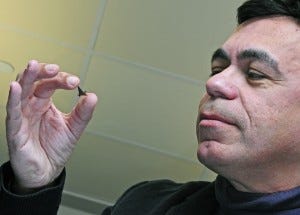Paper Acts as Base for Magnetic Micromotor
January 12, 2010

purdue-ferrofluid-actuator
Purdue researchers have created magnetic ferropaper actuators, which can be designed in various shapes.
Magnets appear to be biomedical researchers' best tools these days. In recent months, Medtech Pulse has reported on the use of magnets for cell sorting in diagnostic applications and magnetic fields to control a membrane's porosity for drug-delivery systems. Now, researchers from Purdue University (West Lafayette, IN) have developed magnetic ferropaper actuators with potential medical applications.Led by Babak Ziaie, professor of electrical and computer engineering and biomedical engineering, the scientists impregnated paper with mineral oil and magnetic iron nanoparticles with 10-nm diameters. Next, they coated the ferrofluid-impregnated paper with parylene. This step serves to prevent fluid evaporation and to equip the technology with water resistance, strength, stiffness, and elasticity.When exposed to a magnetic field, the finished ferropaper responds through controlled motion. As a low-cost actuator, this paper-based product could be used as micromotors in surgical instruments or miniature tweezers employed in the study of cells.Because the actuators rely on a paper base, their manufacture is inexpensive and is safe for in-body use because the material should not damage internal cells and tissues, according to the researchers. Furthermore, the scientists believe that fabrication is not limited by paper type; however, they recommend the use of newspaper or soft tissue paper owing to their desirable porosity.Design freedom could also be a benefit, as the researchers have not yet discovered any limitations dictated by the ferropaper's shape. They are conducting further research, however, by experimenting with origami and other shapes.
One such experimental shape was a small cantilever. "Cantilever actuators are very common, but usually they are made from silicon, which is expensive and requires special cleanroom facilities to manufacture," Ziaie says. "So, using the ferropaper could be a very inexpensive, simple alternative. This is like 100 times cheaper than the silicon devices now available."
Do you have application-specific or general questions about motors as they relate to medical devices? If so, get them answered by our resident motors expert from Maxon Precision Motors.
You May Also Like


